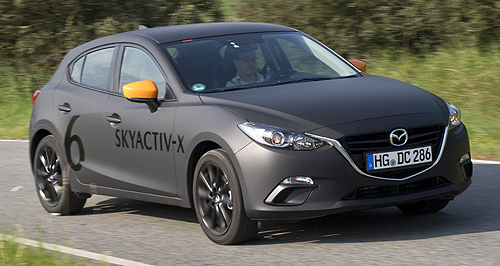News - Mazda - Mazda3Mazda defends small-car suspension rethinkValue play: Mazda’s R&D chief Kiyoshi Fujiwara says the decision to switch from multi-link to torsion beam rear suspension on the next Mazda3 was based on “value for the customer” – not cost. Refinement, dynamics – not cost – behind torsion beam rear switch for 2019 Mazda310 Sep 2017 By BYRON MATHIOUDAKIS in FRANKFURT MAZDA Motor Corporation head of research and development Kiyoshi Fujiwara has defended the company’s controversial decision to switch from a multi-link rear suspension design to an all-new torsion beam arrangement for the next-generation Mazda3 due in 2019. While details are scant, the compact semi-independent layout, as part of the second-generation SkyActiv-X architecture, is said to be far more effective in reducing road and tyre noise in the Mazda3 cabin, thus addressing one of the biggest criticisms of the current model. Mr Fujiwara said the change was not based on cost grounds – even though a multi-link suspension is typically a more complicated and expensive design than torsion beam – but to improve refinement as well as dynamic performance. “Changing from the multi-link to a torsion beam was definitely not on cost grounds,” he said. “We are focusing on the value for the customer, therefore we selected this kind of torsion beam axle instead of the multi-link suspension. “Also, our expert in chassis dynamics already has tested (the new platform) for high-speed, bumpy roads, and everything is better than the current Mazda3’s multi-link suspension.” Mr Fujiwara explained that newly developed rubber bushes in the trailing link of the new suspension had met the company’s requirements. “So far, it’s been very difficult meeting vehicle dynamics, ride comfort and reliability but we have managed it with these special bushes on a torsion beam axle,” he said. “Also the torsion beam axle is much, much better than multi-link suspension in terms of road noise, so we selected that in reducing road noise for customers. “We got a lot of complaints (about the noise) from the media.” Mr Fujiwara revealed that Mazda was inspired by some of the better French torsion beam applications such as the one employed in the T9-series Peugeot 308, which also features related bush component designs to quell noise, vibration and harshness intrusion into the cabin. “We investigated the Peugeot, of course,” he said, acknowledging that it was one of the prime benchmarks for the next-generation Mazda3. According to Mazda Australia managing director Vinesh Bhindi, the loss of the multi-link should not alienate enthusiastic drivers who may have previously been attracted to the Mazda3 because of its sophisticated suspension engineering and resulting dynamic aptitude. “In the end it’s about the whole package,” he said. “From what I hear from the (Mazda) experts, they don’t believe that to be an issue, but I think you have to evaluate the whole package as opposed to one component that is probably traditionally seen as not the best.” Mr Bhindi revealed that while nothing specifically Australian-biased has been engineered into the next-generation Mazda3, plenty of information has been gleaned from real-world testing in this country for a range of models. “A lot of research and development engineers do come to Australia to undertake a lot of driving testing,” he said. “They obtain a lot of data, and even data gathered from Australian staff currently driving Mazda cars. But they are also seeking a lot of input from a lot of the major markets.” After years of using a twin-trapezoidal link arrangement, Mazda switched to a multi-link as per the layout dictated by Ford’s C1 platform architecture driven by the second-generation Focus when the 323/Familia series became the Mazda3/Axela in late 2003.  Read more |
Click to shareMazda articlesResearch Mazda Mazda3 pricing
Motor industry news |
















Facebook Twitter Instagram